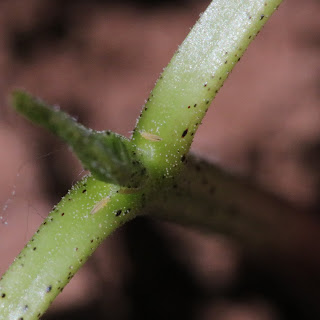I have noticed some thrips damage on the early planted
cotton especially in the areas north of Lubbock. Fields that have already reached
4 true-leaf stage are pretty much safe from further thrips damage. We still,
however, have a lot of late-planted cotton in South Plains that ranges from emergence
to 1st or 2nd true-leaf stages which are very prone to
thrips injury. Late planted cotton usually escapes peak thrips flight but the
fields at the most vulnerable stages especially
those in the vicinity of maturing wheat or pastures will have to be
watched closely for thrips.
In general, with the current hot and mostly sunny
days, I would not be too aggressive when it comes to spraying as cotton plants can
outgrow thrips under good growing conditions. Having said that, I wouldn’t wait
too long either if the damage is being done. Spraying for thrips after the 3rd
true-leaf stage contributes little towards the yield—so the timing is critical!
What
are thrips?
Thrips are early-season pests of seedling cotton. They
are numerous in cotton grown near maturing small grains (wheat) or seedling
corn. Thrips attack leaves, leaf buds, and very small squares (flower buds),
causing a silvering of the lower leaf surface, deformed or blackened leaves, and
terminal and square loss. Feeding most often occurs in the new terminal growth
and on the underside of the leaves. Their feeding ruptures cells, causing
stunted plants and crinkled leaves that curl upward. Severe infestations can
destroy terminal buds, causing excessive branching of the plants and delayed
plant growth.
 |
| No damage to severe thrips damage |
How
do I scout for thrips?
Begin inspections once the cotton reaches approximately
50 percent stand emergence. Thrips can migrate in great numbers from adjacent
weeds or crops, especially small grains (wheat), and cause significant damage within
a few days. Randomly select 20-25 plants from different parts of the field and
closely examine them, looking for adult and immature thrips. Look carefully through
the terminal growth, picking it apart with a pencil lead or other pointed
object, uncurling all the leaves—thrips often hide in tight locations, especially
during rainy, windy conditions.
 |
| Thrips on plant terminal |
What
are the thresholds and control options for thrips?
The threshold for thrips is 1 thrips per true leaf (i.e.
at 2 true leaves, it would be 2 thrips per plant; at 3 true leaves, the
threshold would be 3 thrips per plant and so on). Research shows that applying
foliar sprays after significant thrips damage has occurred results in little or
no benefit. Base your decision to apply insecticide on the number of thrips
present and the plant development stage. Foliar insecticides for thrips provide
maximum benefit when applied at or before the second true leaf emerges. Sprays
at the four and five-leaf stage after the damage is already done are typically
for revenge, rather than yield.
Seed treatments with neonicotinoids (e.g. imidacloprid
and thiamethoxam) are still proving to be effective controlling thrips in the
Texas High Plains region. However, under heavy thrips pressure, foliar
treatment is often needed on the top of seed treatment. Presence of immatures and
injury symptoms on plant are good indicators of whether the seed treatments are
working or not. As far as foliar treatments are concerned, acephate,
dicrotophos (e.g. Bidrin 8EC), and spinetoram (e.g. Radiant SC) all provide an
excellent thrips control. You can
tank mix your insecticide with a post emergence herbicide application. The
decision you will likely make is whether to be timely for the weeds or the
thrips.
